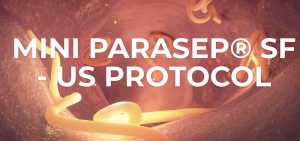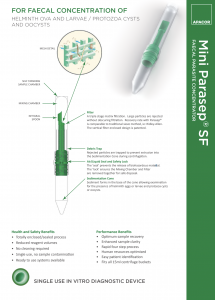The main importance of the study of parasitology is that many of the "tropical diseases" we know are of parasitic origin and are largely due to lack of hygiene and favorable environmental conditions in underdeveloped countries (approximately 75% of the world's population). By means of the concentration technique we can separate the parasites from the fecal matter. Such techniques not only increase the number of parasites in the sediment but also unmask them, making them more visible by removing organic and inorganic waste.. 15ml parasitic concentrator tubes fecales, for the easy and efficient concentration of Helminth Eggs and larvae, Protozoan Cysts and Oocysts.
15ml parasitic concentrator tubes fecales, for the easy and efficient concentration of Helminth Eggs and larvae, Protozoan Cysts and Oocysts.
HEALTH AND SAFETY BENEFITS
Fully closed/sealed process
Disposable device
Single-use, eliminates cross-contamination
Preloaded systems available.
PERFORMANCE BENEFITS
Optimal sample recovery
Improved sample clarity
Quick four-step process
Optimized human resources
Reduce human error
It is important to know the advantages of the methodologies for the final examination of parasites
.
Please see study done:
Other comments on the
formaldehyde-ether concentration
Technique for fecal parasites
A. V. H. ALLEN and D. S. RIDLEY From the
Tropical Disease Hospital, St Pancras
Camino, London
The simplified version of Ritchie's formaldehyde-ether technique for the concentration of fecal cysts, ova and
larvae (Ridley and Hawgood, 1956), which is no less
effective than the original, has been quite widely
adopted as a useful routine diagnostic procedure.
With more experience, however, three objections
have become evident, which apply to some others as well.
Concentration methods: (1) The degree of concentration of Taenia and Ascaris (especially infertile Ascaris)
the egg is unsatisfactory in some cases; and the concentration of Schistosoma eggs is less than optimal. (2)
It is difficult to make the concentrated reservoir stick.
to a microscope slide for fixation and staining. (3) The
concentration of faecal samples, fixed in bulk and
stored for a period of days or weeks, it is not satisfactory.
The purpose of this paper is to describe
Other simple modifications that go beyond the
The first two of these objections. For the complete study on the results of the different techniques.
 APAFIX
APAFIX
Universal fixative patented by Apacor for larvae, protozoa costs and Oocystos.
Features and Benefits
Simplifies sample processing.
Formalin-free fixative
No warning labels: non-toxic, non-flammable, eco-friendly
Suitable for all parasitological fixings
Preserves morphology even with delicate organisms
Compatible with PCR and other molecular methods
It can be used in conjunction with EIAs.
Suitable for use with a variety of common staining techniques
Available in transport vial and vials filled with Parasep®
10% FORMALIN FIXATIVE IN WATER
This preservative is a good general fixative and will fix both eggs and cysts, although it only preserves the internal morphology of cysts for up to 6 months, after which the cytoplasm of the organism becomes granular with poor nuclear definition.
SODIUM ACETATE FORMALIN ACETIC ACID (SAF)
SAF fixed material is suitable for direct examination, concentration (formalin/ethyl acetate) and permanent staining.
.
MERTHIOLATE-IODINE FORMALIN (MIF)
Ethyl-formaldehyde acetate concentration methods can be performed on samples preserved in MIF.
POLYVINYL ALCOHOL (PVA)
This method will preserve the eggs, larvae, and trophozoites well, but the cysts may show some distortion. However, some eggs and cysts do not concentrate well when preserved in PVA..
 General Catalogue G&H Steinvorth
General Catalogue G&H Steinvorth

